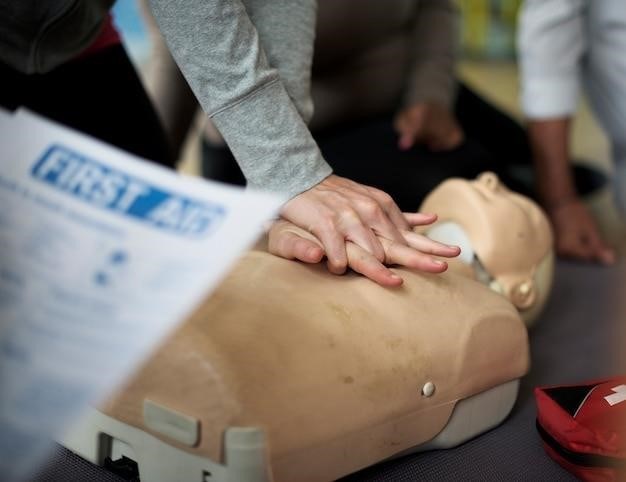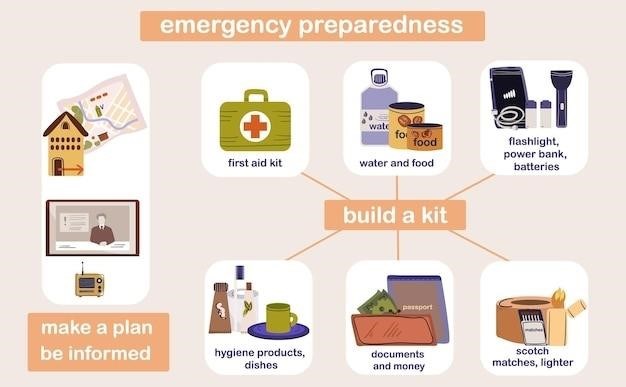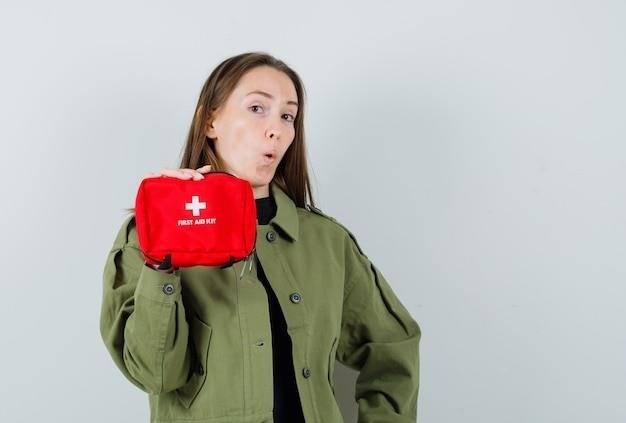This comprehensive guide covers essential first aid and CPR techniques, including basic life support, AED usage, and emergency response. Learn to recognize and react to various emergencies, administer first aid for common injuries and specific situations, and prevent heat/cold-related issues. Master advanced procedures and continue CPR until help arrives. This guide provides crucial life-saving knowledge.

First aid and CPR are vital skills for handling medical emergencies. First aid encompasses a broad range of responses to life-threatening situations, from assessing the scene and casualty to treating injuries like bleeding and burns. CPR, or cardiopulmonary resuscitation, focuses specifically on restoring breathing and circulation in individuals experiencing cardiac arrest. Knowing both enhances your ability to save lives. This introductory section lays the groundwork for understanding the core principles and techniques involved, providing a foundation for mastering life-saving skills. Effective first aid and CPR require quick thinking, proper technique, and confidence built on training. The information presented here will help you become equipped to handle a wide array of emergency scenarios, providing critical assistance until professional medical help arrives. Remember, every second counts in an emergency; preparedness is key.
Basic Life Support⁚ CPR Techniques
Basic Life Support (BLS), including CPR, is crucial in cardiac arrest. Effective CPR involves chest compressions and rescue breaths, aiming to circulate blood and oxygen. The American Heart Association (AHA) and American Red Cross (ARC) guidelines recommend a compression-to-breath ratio of 30⁚2 for adult victims. For infants and children, this ratio may differ. Proper hand placement is vital; for adults, use two hands in the center of the chest, while for children, use one or two hands depending on size. Compressions should be smooth, consistent, and at a depth of at least 2 inches for adults. Ensure complete chest recoil after each compression to allow the heart to refill with blood. Rescue breaths should be given gently, and the victim’s airway should be checked and cleared before starting. Continuous CPR is performed until professional help arrives or the victim shows signs of recovery. Regular training and practice are essential for proficiency in CPR techniques.
Using an Automated External Defibrillator (AED)
An Automated External Defibrillator (AED) is a portable device that analyzes the heart rhythm and delivers an electric shock (defibrillation) to restore a normal heartbeat in cases of sudden cardiac arrest. AEDs are designed for easy use by laypersons, with clear audio and visual instructions guiding the user through the process. Before using an AED, ensure the area is safe and the victim is lying on a flat, dry surface. Turn on the AED and follow the voice prompts. The device will analyze the heart rhythm. If a shock is advised, the AED will indicate this and instruct the user to ensure no one is touching the victim before delivering the shock. After the shock, immediately resume CPR, as per current guidelines (usually 30 chest compressions followed by 2 rescue breaths). Continue CPR and AED cycles as directed by the device until emergency medical services arrive or the victim shows signs of recovery. Regular training is crucial to effectively and confidently utilize an AED in emergency situations. Knowing how to operate an AED can significantly increase the chances of survival for victims of sudden cardiac arrest.
Recognizing and Responding to Emergencies
Effective emergency response begins with recognizing the signs of a life-threatening situation. This involves assessing the scene for safety hazards before approaching the victim. Key indicators of emergencies include unconsciousness, difficulty breathing, severe bleeding, and signs of shock (pale skin, rapid pulse, etc.). Once an emergency is identified, immediately call for professional medical assistance (emergency services). While waiting for help to arrive, provide appropriate first aid. This might involve checking for responsiveness and breathing, initiating CPR if necessary, controlling bleeding with direct pressure, and stabilizing injuries to prevent further harm. Remember to remain calm and reassure the victim. Clear communication with emergency services is vital; provide concise information about the location, nature of the emergency, and the victim’s condition. Effective communication and quick action can significantly improve the outcome of an emergency situation.
First Aid for Common Injuries (Bleeding, Burns, etc.)
Effective first aid for common injuries is crucial in minimizing harm and improving recovery. For severe bleeding, apply direct pressure to the wound using a clean cloth, elevating the injured limb if possible, and seeking immediate medical attention. Minor cuts and scrapes should be cleaned gently with soap and water, and covered with a sterile bandage. Burns require immediate cooling under cool (not ice-cold) running water for at least 10-20 minutes. Do not apply ice or butter. Remove any constricting clothing or jewelry. Cover the burn with a sterile, non-adhesive dressing. For fractures, immobilize the injured area using splints or slings to prevent movement, and seek professional medical help. Sprains and strains need rest, ice, compression, and elevation (RICE method). Monitor the victim for signs of shock and provide appropriate care. Remember, these are basic guidelines, and the severity of the injury will dictate the necessary actions. Always consult with medical professionals for serious injuries, or if you are unsure about how to proceed.
First Aid for Specific Situations (Choking, Drowning, etc.)
Responding effectively to specific emergencies like choking and drowning requires immediate action and knowledge of appropriate techniques. For choking, determine if the person can cough or speak. If not, perform abdominal thrusts (Heimlich maneuver) for adults and back blows and chest thrusts for infants and children. If the person becomes unconscious, begin CPR. In cases of drowning, remove the victim from the water ensuring your own safety. Check for breathing and pulse. If absent, immediately commence CPR, prioritizing chest compressions. Rescue breaths should be given after the initial compressions. Once the victim is breathing and has a pulse, monitor closely for potential complications and seek immediate medical attention. For seizures, protect the person from injury by clearing the area around them. Do not restrain them. Turn them onto their side to prevent choking on vomit or saliva. Time the seizure and seek medical attention afterward. For severe allergic reactions (anaphylaxis), administer epinephrine (if available and the person has a prescription) and call emergency services immediately. Timely intervention is crucial in all these situations.
Preventing Heat and Cold-Related Emergencies
Heat-related emergencies, such as heat exhaustion and heat stroke, are preventable with proper precautions. Stay hydrated by drinking plenty of water, especially during strenuous activity or hot weather. Wear loose, light-colored clothing and limit exposure to direct sunlight during peak hours. Seek shade or air conditioning regularly. Cold-related emergencies, including hypothermia and frostbite, demand similar vigilance. Dress in layers of warm clothing, covering exposed skin. Wear waterproof outer layers to protect against moisture, which accelerates heat loss. Be mindful of wind chill, as it significantly increases the risk of hypothermia. Avoid prolonged exposure to cold temperatures and monitor for signs of frostbite, such as numbness, tingling, or discoloration of fingers and toes. If exposed to extreme cold, seek shelter immediately and warm the body gradually. Understanding these preventative measures can significantly reduce the risk of heat and cold-related health issues.
Dealing with Bites, Stings, and Poisonous Plants

Insect bites and stings can range from minor irritations to severe allergic reactions. For insect stings, remove the stinger if present, using a scraping motion rather than squeezing. Clean the area with soap and water. Apply a cold compress to reduce swelling and pain. Monitor for allergic reactions such as difficulty breathing, swelling of the face or throat, or dizziness. Seek immediate medical attention if these symptoms occur. Spider bites may require different treatment depending on the species. Clean the bite area and monitor for infection. Seek medical advice if symptoms worsen or if you suspect a venomous spider bite. Poisonous plant contact can cause skin irritation, blisters, or rashes. Remove contaminated clothing and wash the affected area thoroughly with soap and water. Apply a calamine lotion or hydrocortisone cream to soothe the skin; If a significant reaction occurs, or if you are unsure about the plant’s toxicity, consult a medical professional. Prevention is key⁚ Wear protective clothing when in areas with known poisonous plants or insects, and use insect repellent.
Advanced First Aid Procedures
Advanced first aid procedures require specialized training and should only be performed by individuals with appropriate certifications. These procedures go beyond basic first aid and may involve managing more complex injuries or medical emergencies. Examples include the management of severe bleeding, including the use of tourniquets (only in extreme cases and when properly trained), splinting of fractures, and the treatment of severe burns. Controlling severe bleeding involves applying direct pressure to the wound, elevating the injured limb if possible, and using pressure bandages. Splinting a fracture helps to immobilize the broken bone and prevent further injury. Proper splinting techniques are crucial to avoid causing additional harm. Severe burns require immediate cooling of the affected area with cool (not cold) water and the covering of the burn with a sterile dressing. It’s critical to monitor for signs of shock, such as pale skin, rapid pulse, and shallow breathing. In all cases of advanced first aid, prompt professional medical assistance should be sought. The information provided here is not a substitute for formal training. Always prioritize seeking help from qualified medical personnel.
Continuing CPR Until Help Arrives
Sustaining CPR until professional medical help arrives is paramount in cardiac arrest situations. Uninterrupted chest compressions and rescue breaths, if trained to do so, maintain blood flow to the brain and vital organs, increasing the chances of survival. Fatigue is inevitable, so if multiple rescuers are present, rotations should be implemented to prevent exhaustion. Clear communication among rescuers is key, ensuring smooth transitions and continued effective CPR. Regularly check for signs of life, such as a pulse or spontaneous breathing, after each cycle of compressions and breaths. Even if no signs of life are immediately apparent, continue CPR. The arrival of emergency medical services (EMS) does not automatically signal the end of CPR; follow their instructions for transfer of care. Maintaining consistent and high-quality chest compressions remains critical until EMS personnel take over. The use of an AED, if available, should be integrated into the CPR process according to established protocols. Remember, every minute counts in a cardiac arrest emergency; persistent effort can significantly impact the victim’s outcome. Do not stop until professional help arrives and takes over.
